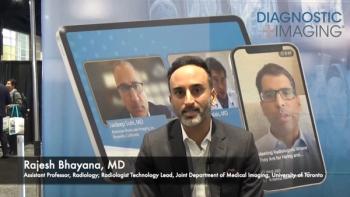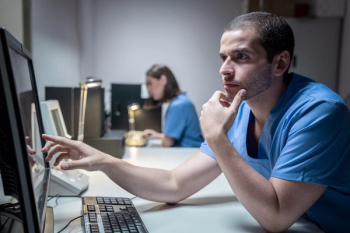
Cardiologist goes undercover to scout PACS
My favorite end-of-day refuge after walking miles in McCormick Place is a minimalist Asian fusion restaurant with delicious food and low prices. I read the RSNA Bulletin. I eat. I depart.
December 2004 - My favorite end-of-day refuge after walking miles in McCormick Place is a minimalist Asian fusion restaurant with delicious food and low prices. I read the RSNA Bulletin. I eat. I depart.
Tonight, a person sporting a green badge, indicating an M.D., sat down at the table next to me. Was this an astute medical director or physician-trained administrator? How wrong I was! This gourmand was a cardiologist seeking truth and wisdom about state-of-the-art PACS.
"What are you doing here?" I asked. "Why don't you attend your own convention, the American College of Cardiology?"
Well, he had, and this cardiologist's tale should be of interest to vendors and radiologists alike.
His suburban practice has several offices situated over a 40-mile area. The partners are busy. None are getting any younger. Access to echocardiograms and x-ray films has been a time-consuming, delay-ridden hassle. One of the hospitals is planning for PACS. Through hospital PACS planning committee meetings, the cardiologists became intrigued.
So when this cardiologist went to the ACC meeting, he looked at the offerings of the cardiac PACS vendors. In his opinion, radiology PACS vendors are light-years ahead in technology development. Ironically, the cardiologist overlooked one system that might work well for his practice. Not knowing this, and armed with hospital-sponsored paperwork, he registered for the RSNA meeting to learn about PACS.
"If only the ACC had this caliber of courses pertaining to PACS," the cardiologist said. "I need to become savvy quickly. Cardiologists cannot keep their heads in the sand. I need to find out if any cutting-edge vendor can meet our needs. Radiologists do not know just how advanced these PACS are."
I asked the cardiologist if he revealed his identity. He asked if I routinely wore a target on my back while walking in the woods during deer hunting season.
"I'm just an inquisitive referring physician," he said.
Was anything else in the technical exhibitions of interest?
"Yes," he replied. "Teleradiology nighthawk services."
The cardiologist explained that he reads some procedures that could be read by a radiologist, but he thinks he interprets them better. But most imaging procedures he performs include additional studies that require the interpretation of a radiologist. Depending on these findings, additional diagnostic procedures may need to be ordered and read by radiologists.
"Rather than evaluate from a financial perspective the additional business I bring to a radiology practice, the partners fret about the loss of revenue for the exams that I do read. Rather than realize that we should be sharing information in a collaborative manner for the benefit of the patient, the radiologists are focused on the concern that I will take their business away. To some extent, I do, but if I bring them business they would otherwise not receive, what is the point? I don't think they bother to analyze this," he said.
The reason the cardiologist met with teleradiology nighthawk services was to identify an alternative radiology practice to supplement the local one. It's a whole new business opportunity for the nighthawks, and it poses some interesting issues about the radiology versus cardiology debate.
"They were surprised, but they were interested," the cardiologist said.
Did the cardiologist find his perfect PACS? He had not, but he'd learned a lot. And he would visit the vendor booth he'd overlooked.
"So when I see your badge with an M.D. tag, I've identified a cardiologist," I said as I was leaving.
"Not really", he replied. "I think I'm outnumbered by orthopedic surgeons. You should hear what they say about what they are seeing for orthopedics on the trade show floor!"
I had to agree. This year's crop of orthopedic workstations is really impressive.
Newsletter
Stay at the forefront of radiology with the Diagnostic Imaging newsletter, delivering the latest news, clinical insights, and imaging advancements for today’s radiologists.




























